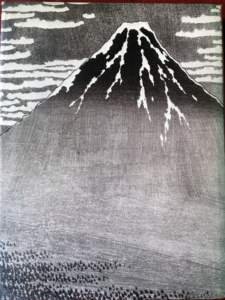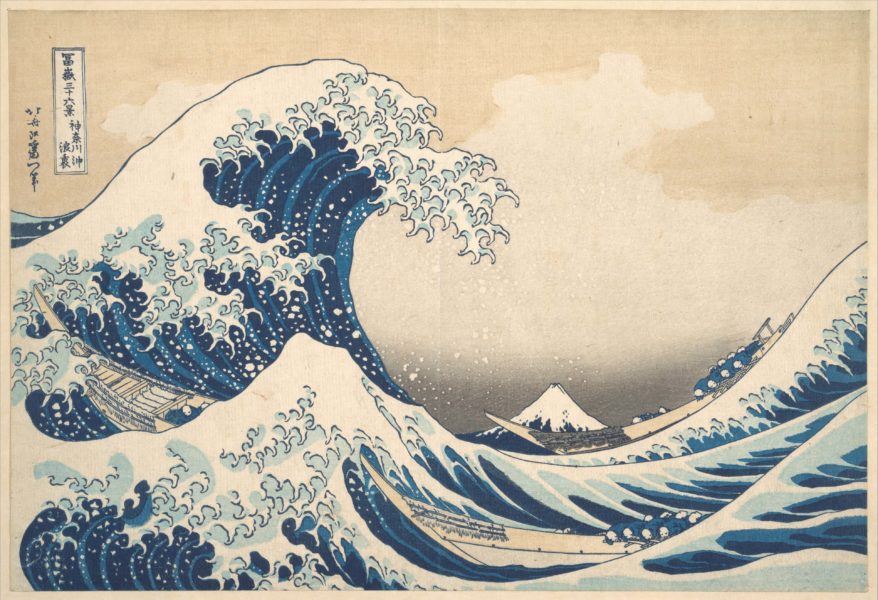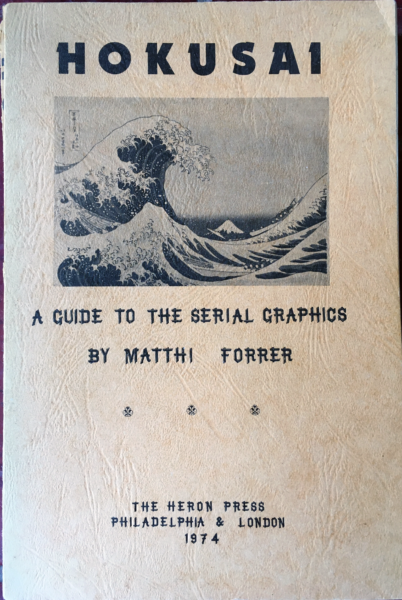Quite surprisingly, we can still find various datings for one of the world’s most iconic images, the Great Wave as it is popularly called, actually titled In the Hollow of the Wave off Kanagawa (Kanagawa oki namiura), one of the prints in Hokusai’s series of Thirty-six Views of Mount Fuji (Fugaku sanjūrokkei).
In earlier literature, this series was usually dated to the 1820s (e.g. Goncourt 1896, p. 162: 1823-29; Holmes 1900, p. 23: 1823-29; Perzynski 1904, p. 76: 1823-29; Binyon & Sexton 1923, p.138: 1825-32; Focillon 1925, p.90: 1823-29; Hillier 1955, p. 60: 1823-29). This dating was based on a misinterpretation of an announcement of – among others – Eight Appearances of Mount Fuji (Fugaku hattai) at the end of his model book for combs and pipes, the Imayō kushi kiseru hinagata, indeed published in V/1823. Indeed, the text of this announcement – “Eight aspects of Mt. Fuji. The four seasons, Weather clear and rainy, Wind-snow-mist, Duly following the sublime creations of heaven: All the variations of scenic beauty caught on the artist’s brush-tip” (here cited after Lane 1989, p. 184) – would perfectly suit the Fuji series – and it might well represent the artist’s first ideas for the Fuji series.
However, in 1944, Narazaki Muneshige would in his Hokusai ron (p. 378) be the first to identify a true announcement of the Fuji series of prints, at the back of part 12 of the popular novel Shōhon jitate by Ryūtei Tanehiko, illustrated by Utagawa Kunisada and published in I/1831.
In this advertisement, the publisher Nishimuraya Yohachi announces “The Thirty-six Views of Mount Fuji, drawn by the Old Man Iitsu, formerly known as Hokusai: Single sheet prints in blues [that is so-called aizurie] each featuring one view and to be issued one after the other. These prints show how the shape of Mount Fuji is different when seen from various locations, such as from the coast of Shichirigahama, or more distantly from the Island of Tsukudajima, and so on. On the whole they are of use to those wishing to learn and paint remarkable landscapes. The blocks being cut and printed successively, they may well amount to more than a hundred, and so not restricted to thirty-six plates only.”
Ever since, and especially after Suzuki Jūzō had published an overview of the subsequent Nishimuraya advertisements for Hokusai’s various landscape series, the dating of the series came to be revised to the 1830s (Forrer 1974, p. 87: 1826-33; Kobayashi 1976, pp. 61f.: 1831-33; Forrer 1988, p. 264: 1831-33; Lane 1989, p. 184: 1830-32; Forrer 1991, cat. 11: 1830-35; Forrer 2010, p. 183: 1830-34; Asano 2010, p. 4: 1830-34; Thompson 2015, cat. 20-23: c.1830-31; Sumida Hokusai Museum 2016, cat. 61: c.1831; Clark 2017, p. 108: 1831-33).
So, even though we may all agree that Nishimuraya announces the Fuji series to be published as “prints in tones of blue” (aizurie) in I/1831, we cannot, it seems, agree upon either the date when the first prints were launched (is it 1830 or 1831?), or when the series was completed (1832, 1833, 1834, or 1835). In the Fuji series, we know of ten designs issued in tones of blue, as aizurie. Moreover, we know of some more aizurie by Hokusai, issued by different publishers. It may be good to first have a closer look at these novelties, that is what aizurie were considered at the time — to be continued (I just hope this may help you with better information than Wikipedia that says of the Great Wave: It was published sometime between 1829 and 1833 in the late Edo period as the first print in Hokusai’s series Thirty-six Views of Mount Fuji)

(Ukiyoe Taikei 13)









